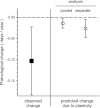Phenotypic plasticity alone cannot explain climate-induced change in avian migration timing
- PMID: 23145329
- PMCID: PMC3492770
- DOI: 10.1002/ece3.367
Phenotypic plasticity alone cannot explain climate-induced change in avian migration timing
Abstract
Recent climate change has been linked to shifts in the timing of life-cycle events in many organisms, but there is debate over the degree to which phenological changes are caused by evolved genetic responses of populations or by phenotypic plasticity of individuals. We estimated plasticity of spring arrival date in 27 species of bird that breed in the vicinity of an observatory in eastern North America. For 2441 individuals detected in multiple years, arrival occurred earlier during warm years, especially in species that migrate short distances. Phenotypic plasticity averaged -0.93 days °C(-1) ± 0.70 (95% CI). However, plasticity accounted for only 13-25% of the climate-induced trend in phenology observed over 46 years. Although our approach probably underestimates the full scope of plasticity, the data suggest that part of the response to environmental change has been caused by microevolution. The estimated evolutionary rates are plausible (0.016 haldanes).
Keywords: Bird migration; evolution; phenology; phenotypic plasticity; temperature.
Figures


References
-
- Ahola MP, Laaksonen T, Eeva T, Lehikoinen E. Great tits lay increasingly smaller clutches than selected for: a study of climate- and density-related changes in reproductive traits. J. Anim. Ecol. 2009;78:1298–1306. - PubMed
-
- Baayen RH, Davidson DJ, Bates DM. Mixed-effects modeling with crossed random effects for subjects and items. J. Mem. Lang. 2008;59:590–412.
-
- Barton N, Partridge L. Limits to natural selection. BioEssays. 2000;22:1075–1084. - PubMed
-
- Berthold P. Control of bird migration. London: Chapman and Hall; 1996.
-
- Both C, Visser ME. Adjustment to climate change is constrained by arrival date in a long-distance migrant bird. Nature. 2001;411:296–298. - PubMed
LinkOut - more resources
Full Text Sources

